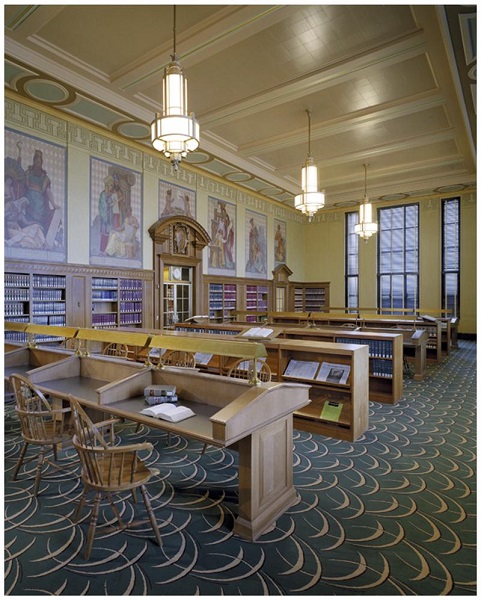Many courthouses, particularly large urban trial courts, have a law library located on their premises. The size of the law library and the frequency of its use varies considerably from court to court. Law libraries are used by judges, judicial staff, attorneys, and the public. While some courts have an organized law library complete with a librarian and library staff, the library in many courts is unstaffed. Courts, judges, prosecutors, public defenders, and the local bar may also have separate collections. Even with a central collection, judges should have a minimum set of reference materials in their chambers. Occasionally, the library may double as a conference room or training room, as long as the activities do not interfere with normal library use. For additional standards governing law libraries, see American Association of Law Libraries' Standards for County Law Libraries.
With an increasing number of legal references available on-line, the need for large physical collections is diminishing. Judges can have access to a full-range of legal reference materials in his or her chambers using a desktop PC or notebook computer.

Ohio Judicial Center Reading Room
A law library should be available and conveniently located to all users, particularly judges, law clerks, and attorneys. In those situations where the library is open after hours, it should have a separate entrance.
The law library should be convenient to all users. If the library is intended for after-hours use, it should be located low in the courthouse, possibly with its own separate entrance, to minimize the traffic and security risks of other areas in the courthouse. The library should be located near public restrooms, a water fountain, and a telephone for users.
In larger jurisdictions, the law library may contain an open study area with microfilm reader and printer, on-line computer facilities to access automated legal research databases, photocopy room, staff workroom, circulation desk, staff computer room, staff offices, staff lounge and toilet facilities, book stacks, and microform storage areas.
The law library should have a quiet atmosphere and there should be natural lighting, especially in the work areas. Because much research requires the use of numerous legal texts, adequate work surfaces, such as large tables, should be provided in addition to the smaller carrels.
Free-standing shelves provide maximum flexibility. The units should have adjustable shelves, and space between the shelves should be a at least 36 inches.
The library must provide access to persons with disabilities.
Court staff should be able to supervise the library easily. Arrangements should be made for after-hours security; larger libraries may need anti-theft devices.
The size of the law library will depend upon the current collection of books and periodicals, as well as future expansion. Space should be allocated for a public counter, catalog area, public duplication area, reading and research space with desks and carrels, open and closed stack shelving and storage, microfilm processing and storage, and staff spaces, including offices, conference space, and supply areas.
Due to the weight of the books and other materials, the library should be located on lower floors, especially when renovating older court facilities or constructing large court facilities with a large law library. The live-load capacities recommended by the Building Officials and Code Administrators International, Inc. (BOCA) National Building Code are 60 pounds/square feet for reading rooms and 150 pounds/square feet for library stacks. For most law libraries, 125-150 pounds/square feet live load should be adequate. The library should provide terminals and printers for legal database research. Public work areas may be equipped with power outlets, data terminals, and phone jacks to permit patrons to make use of personal computers to do research and access the court information systems.
